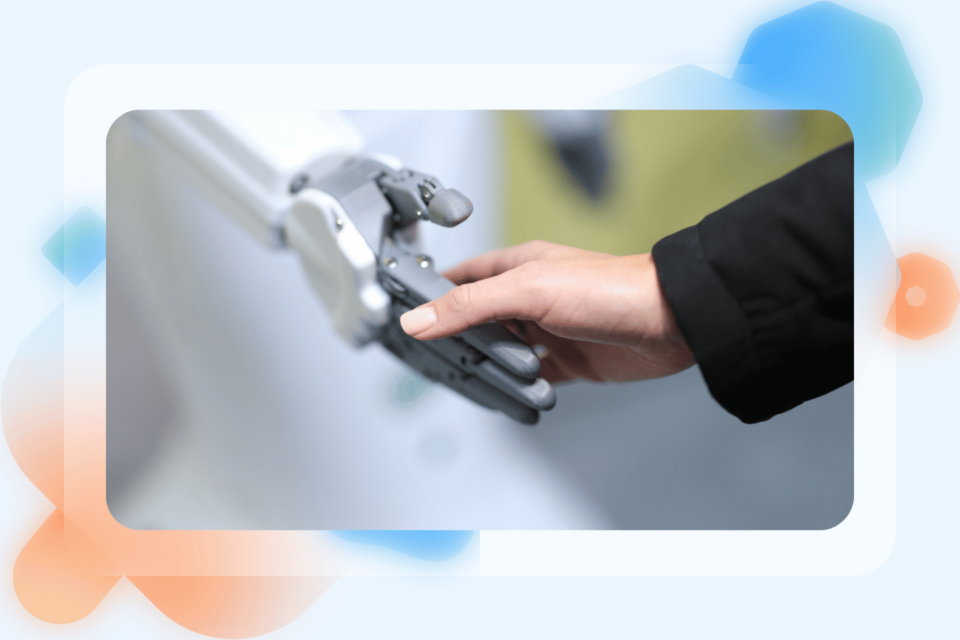If your CS team still struggles to deliver exceptional support even after you optimize your approach—it’s time to reevaluate your customer service strategy. Your automation efforts aren’t getting you the results you desire. An automated customer service system can handle high-volume, simple tasks, allowing human representatives to focus on more complex issues.
Does your automation for customer service only incorporate canned responses? Think about this: they reduce response times, but they also reduce personalization as well. More than half (52%) of consumers are very likely to abandon a brand if its communication isn’t personalized.
To truly leverage customer service automation, consider these 10 actionable tips below.
Understanding customer service automation

Automated customer service isn’t about replacing your team but supercharging their capabilities. Automated customer service systems are a transformative way to enhance efficiency, improve support quality, and provide round-the-clock service.
What is automated customer service?
Customer service automation is the use of technology to enhance (remember, NOT replace!) support operations. It’s about leveraging smart systems so your human agents are reserved to tackle more complex, high-value interactions. The common way how to automate customer service involves using chatbots to answer frequently asked questions or helpdesk software to resolve issues more efficiently.
Benefits of automating customer service

It improves efficiency
One of the biggest perks of customer service automation solutions is the boost in efficiency provided by automated customer service tools. When routine customer service tasks are automated, your team can focus on more high-value activities. In fact, automation increases productivity by 30%.
It makes you available 24/7
Do you have a global audience? Well, your customers don’t stop needing help just because it’s 5PM in your timezone. With automation, your service is always on—24/7 support—and that’s favorable to 64% of consumers expecting real-time interactions and responses.
It’s more than just labor savings
Let’s face it—staffing a customer service team around the clock costs money. Chatbots in customer support can handle simpler, repetitive tasks. And they’re way cheaper. But more than that, automation can help reduce errors and mistakes. It’s reported that automated systems can save you 30% on customer service.
It delivers a uniform, high-quality customer experience across all interactions
Customer satisfaction increases when customers receive quick, accurate responses. Two-thirds of customers even say speed and price matter equally. Also, automated systems deliver standardized responses to common customer questions, so you’re always consistent. By leveraging customer data, these systems can further enhance the customer experience and streamline processes.
It’s easier to scale
Scaling your support operations becomes more manageable with automation. The more your business grows, the greater the demands on your customer service team. Thankfully, customer service automation solutions can handle thousands of simultaneous interactions—around 80% of routine inquiries can be handled with chatbots, says IBM.
10 tips for customer service automation

Tip # 1. Identify what needs to be automated
Before diving into automation, it’s crucial to pinpoint customer service workflows that would benefit most from it. Not all tasks are suitable for automation—emotional support can’t be automated, right? 50% of support tickets can be easily automated using customer service automation platforms.
So, identify the tasks that are repetitive, time-consuming, and don’t require significant human judgment. For instance, frequently asked questions, password resets, order status inquiries, and basic troubleshooting are prime automated customer service examples. These tasks don’t require the problem-solving skills or emotional intelligence of human agents.
Best practices to nail it:
- Map out your customer journey.
- Prioritize tasks that are suitable for automation based on their frequency, complexity, and potential impact.
- Use surveys, direct feedback, and customer feedback to determine which tasks they find most frustrating or time-consuming.
Tip # 2. Choose the right tools
The customer service automation tools you choose will directly impact the effectiveness of your automation efforts. But what does ‘right tools’ mean? These are tools that align with your specific business needs. Ideally, they’re user-friendly for both your team and customers, and scalable. 74% say a better software user experience for agents can improve customer service
When choosing automation tools, consider the following factors:
- Your financial resources and the extent of your customer service operations
- Specific functionalities you need
- Ease of use
- Integration capabilities
Best practices to nail it:
- Research different automation platforms and compare features.
- Take advantage of the tool’s free trials or demos.
- Choose a solution scalable to your business needs.
Tip #3. Set up chatbots for instant support
Chatbots are automated programs designed to simulate human conversation. Modern chatbots are powered by artificial intelligence (AI) and natural language processing (NLP). So, they can respond to a wide range of customer inquiries. 62% even prefer engaging with them over waiting for a human.
Moreover, chatbots deliver instant replies, eliminating those frustrating wait times. It’s no wonder 90% of customers rate an “immediate” response as crucial for customer service inquiries, according to HubSpot.
Best practices to nail it:
- Develop clear chatbot scripts to handle the most frequently asked questions and tasks
- Train your chatbot to handle a variety of customer questions.
- Ensure a smooth handoff to human agents when necessary
Tip #4. Customize automation processes to business needs
Off-the-shelf automation solutions are rarely a perfect match out of the box, which is why customization is crucial. Customizing your automation processes ensures that they align with your specific workflows, customer demands, and business goals.
For example, you should:
- Assign tickets according to specific criteria: Such as product type, segmentation of customers, or the severity of the issue.
- Set up automatic escalation procedures: For high-priority issues or when specific conditions are met like if an issue hasn’t been resolved within 48 hours, the system can automatically send a follow-up email to the customer or escalate the issue internally.
Best practices to nail it:
- Involving your customer service agents in the customization process: They have firsthand knowledge of your workflows and customer needs.
- Testing the customized automation processes thoroughly: To ensure they work as expected and don’t introduce new problems.
- Keeping detailed documentation: Of your automation processes to facilitate maintenance and troubleshooting.
Tip #5. Integrate CS automation tool with existing CRM
Siloed systems won’t cut it today. When all touchpoints—chat, email, phone, social media—are logged in one system, you gain a comprehensive, 360-degree view of each customer. No more fragmented information or manual data entry. It’s only a seamless, coordinated approach to customer service.
Here are other reasons why this integration matters:
- Empower your agents to deliver the tailored, consistent experiences that 59% of consumers say are crucial for winning their loyalty.
- Integration eliminates the need for manual data entry and ensures that customers receive consistent service across all channels
- Your support team has all the customer intel they need right at their fingertips.
Best practices to nail it:
- Align data fields in both systems to capture the most relevant information
- Leverage APIs for real-time synchronization and up-to-date data
- Continually monitor and optimize the integrated system as needed
Tip #6. Put a training plan in place for your staff
Yes, customer service automation platforms are game-changers. But only if your team uses it right. Even the most advanced CS tools fall short without proper training for the users. Truth is, introducing automation represents a major shift, and if your staff isn’t prepared, it can cause plummeting productivity.
Did you know that 67% of the world’s workforce is unengaged? But 79% of employees who take part in formal training are engaged in their work. So, what should your training plan look like?
- Cover the fundamentals—how the tools work, how they integrate with existing systems, and the specific tasks they automate.
- Provide hands-on training on the customer service automation software: features, functionalities, and troubleshooting.
- Offer ongoing education through refresher courses, webinars, and workshops.
- Create detailed documentation like user manuals, step-by-step guides, video tutorials, and FAQs.
- Address concerns and resistance with open communication and support.
Best practices to nail it:
- Customize training based on roles.
- Use real-life examples and scenarios your team is likely to encounter
- Combine classroom, online, and hands-on training for diverse learning styles
Tip #7. Outsource an entire customer service team already experienced in strategy and tools
Talking about building a dedicated CS team with deep expertise in automation know-how is a huge move. Their existing skills and knowledge mean they can hit the ground running, quickly implementing effective service strategies and maximizing your investment. And this is particularly beneficial for rapidly growing businesses or those lacking in-house resources, especially in terms of cost savings.
Best practices to nail it:
- Encourage your new automation experts to share their knowledge with the rest of the team.
- Involve these experienced hires in strategic decision-making around customer service and automation.
- Position them as valuable resources who can uplift the entire team through collaboration.
Tip #8. Personalize automated interactions
Forget the idea that automation means cold, robotic interactions. A majority of customers (83%) are happy to share their data so they can receive personalized services. So, with the right approach to automated customer service responses, you can use it to create personalized experiences that’ll make your customers feel valued.
Personalization [of emails] increases transaction rates by 6x. Get it right, and you’ll see the difference in customer satisfaction and loyalty. Here’s how:
- Leverage your CRM, past interactions, and customer profiles.
- Customize responses based on the context.
- Segment customers by purchase history, demographics, or engagement level.
Best practices to nail it:
- Analyze interactions to spot personalization opportunities.
- Use customer names (it works wonders for connection!).
- Keep personalization consistent across all digital channels (email, SMS, social media).
Tip #9. Build a comprehensive knowledge base
Want to supercharge your customer service automation? A solid knowledge base is one of your best weapons. It’s huge because modern customers love finding answers themselves, and you can drop helpful links into your bots and automated responses. The more your customers use it, the fewer support tickets you’ll deal with. What’s even better is that knowledge bases can save businesses an estimated $11.90 per customer interaction.
To create a KB that rocks, start by gathering data on common customer issues and prioritizing those topics in your content. Keep it simple and clear—no jargon allowed. Use visuals like screenshots and videos to boost understanding.
Best practices to nail it:
- Analyze how customers interact with your KB—which articles get the most attention, which search queries are common, and where they lose interest.
- Offer multiple languages if you’ve got a global audience.
- Organize content with categories, tags, and a killer search function.
Tip #10. Embrace omnichannel automation
Think about it, your customers don’t really care about channels. They just want great service everywhere. And approximately 90% want them to be consistent. Omnichannel automation is all about integrating and automating customer service across all your brand touchpoints.
Centralize your automated customer service data first. It’s super essential. So, record and store all interactions in one place, no matter where they happen. Automate routine stuff across channels to free up your team for tricky issues. Think chatbots for common questions on your site and social media, automated email responses for FAQs, and SMS automation for reminders and updates.
Best practices to nail it:
- Track conversations across channels so customers don’t have to start over.
- Keep a unified customer profile accessible everywhere because an average shopper uses six touchpoints.
- And don’t skimp on security—protect each channel against data breaches and encrypt customer info.
Watch out for these pitfalls when implementing automated customer service software
Caution: Automated customer service software can enhance your customer interactions. But it’s not flawless. Because when handled poorly, automation can create more headaches than it solves. Watch out for these common pitfalls:
Over-automation overload
Relying too heavily on bots? Big mistake. Sure, automation’s great for routine stuff, but it can’t replace human empathy and problem-solving skills. Customers still crave that human touch, especially when dealing with complex or emotional issues.
Half-baked implementation
Rushing to deploy automation without proper planning or training? You’re asking for trouble. If your team doesn’t know how to use these new customer service automation platforms effectively, they won’t solve your unique challenges. So, take the time to do it right.
The “set it and forget it” trap
Automation isn’t a one-and-done deal. Customer needs, tech, and business goals are always changing. If you’re not constantly monitoring and tweaking your automated systems, they’ll quickly become outdated, useless, or even harmful to your customer service.
Maximize your customer service automation investment

Automation can revolutionize your customer service. It’s all about automating the boring stuff, offering 24/7 support, and seamlessly integrating with your current systems. But here’s the catch: automation for customer service is only as good as the people behind it. That’s where LTVplus shines.
Our customer service agents aren’t just familiar with customer service software – they’re experts who know all the tricks to squeeze maximum value from your tools. Ready to level up? Reach out now and let’s create a customer experience that’s both efficient and personal.




